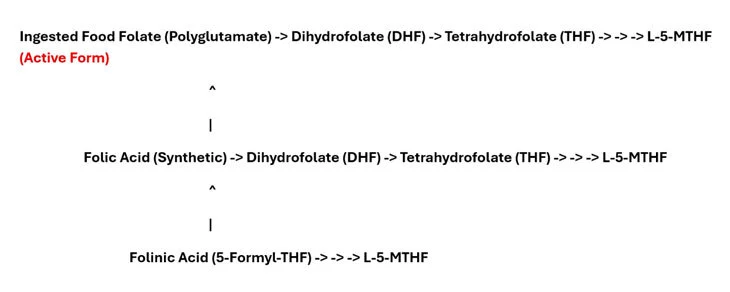
Introduction
Folic acid and folinic acid are both distinct forms of vitamin B9, a crucial nutrient for human health. While often confused, they are not biologically equivalent. The primary difference lies in their chemical structure and their position in the metabolic pathway the body uses to create the active, usable form of folate, L-methylfolate. Folic acid is a fully oxidized, synthetic precursor that requires multiple enzymatic steps for activation. Folinic acid (also known as leucovorin) is a partially reduced, more bioavailable form that is much closer to the active form, bypassing several critical enzymatic steps. This metabolic distinction has profound implications for their use in dietary supplementation, food fortification, and clinical medicine, particularly for individuals with certain genetic polymorphisms or those undergoing specific chemotherapeutic treatments.
Introduction to Folate and its Importance
Folate is a general term for a group of water-soluble B-vitamins that are essential for numerous bodily functions. Their primary roles include:
- DNA Synthesis and Repair: Crucial for the production of purines and pyrimidines, the building blocks of DNA and RNA.
- Cell Division and Growth: Especially important during periods of rapid growth, such as pregnancy and infancy.
- Amino Acid Metabolism: Specifically, the conversion of homocysteine to methionine.
- Methylation Reactions: Folate cycles are central to epigenetic processes that regulate gene expression.
A deficiency in folate can lead to megaloblastic anemia, neural tube defects in developing fetuses, elevated homocysteine levels (a risk factor for cardiovascular disease), and other neurodevelopmental and neuropsychiatric disorders.
Chemical and Metabolic Differences Between Folic Acid and Folinic Acid
The body must convert any ingested folate into the active form, L-5-Methyltetrahydrofolate (L-5-MTHF), to be used at the cellular level.
The Metabolic Pathway Diagram (Simplified):

Folic Acid (Pteroylmonoglutamic Acid)
- Source: Purely synthetic. It is not found in significant amounts in nature.
- Structure: Fully oxidized and stable, making it ideal for fortifying foods (e.g., flour, cereals – added to our food supply to prevent neural tube defects) and manufacturing supplements due to its long shelf-life.
- Metabolism: This is its critical limitation. Folic acid is inert and must be activated in a multi-step process:
- It is first reduced to dihydrofolate (DHF) by the enzyme dihydrofolate reductase (DHFR).
- DHF is then reduced again by DHFR to tetrahydrofolate (THF).
- THF is then converted through a series of reactions into the active L-5-MTHF.
- Key Consideration: The enzyme DHFR has a relatively low activity in humans, and this conversion process is slow and inefficient. Furthermore, unconverted folic acid can circulate in the blood, which may have unintended biological consequences.
Folinic Acid (5-Formyltetrahydrofolate or Leucovorin)
- Source: Can be derived from synthetic processes but is also a natural form found in foods like legumes, leafy greens, and liver.
- Structure: It is a partially reduced form of folate (already a tetrahydrofolate). It is stable in solution.
- Metabolism: Its key advantage is that it bypasses the DHFR enzyme step. Folinic acid is easily converted directly into active L-5-MTHF and other active folate forms through a simple, one-step conversion (it is first converted to 5,10-methylenetetrahydrofolate). This makes it a much more bioavailable and efficient precursor for raising active folate levels in the body.
Clinical and Practical Applications
Their different properties dictate their specific uses.
Folic Acid
- Public Health & Food Fortification: The primary global use. Added to staple foods to prevent neural tube defects in populations.
- Dietary Supplements: Common in over-the-counter multivitamins and prenatal vitamins due to its stability and low cost.
- Treating Nutritional Deficiency: Used to correct folate-deficiency megaloblastic anemia.
Folinic Acid (Leucovorin)
- Folinic Acid “Rescue” Therapy: The most well-known use relates to its administration with the chemotherapy drug methotrexate. Methotrexate works by inhibiting DHFR, shutting down folate metabolism and killing fast-dividing cancer cells. Giving folinic acid bypasses this blockade, “rescuing” healthy cells from the toxic effects of the drug and reducing side effects.
- Antidote for Overdose of Folic Acid Antagonists: Used in overdoses of drugs like trimethoprim (an antibiotic) or pyrimethamine (an antimalarial drug), which also inhibit DHFR.
- Adjunct to 5-Fluorouracil (5-FU) Chemotherapy: Enhances the cytotoxicity and effectiveness of the cancer drug 5-FU by stabilizing its binding to its target enzyme.
- Management of Mitochondrial Disorders: Used in some cases to support cellular energy production pathways.
- Specialized Supplementation: Increasingly used in supplements targeting individuals with the MTHFR gene mutation and in Cerebral Folate Deficiency and Autism Spectrum Disorder, especially in those patients that are positive for folate receptor autoantibodies.
The MTHFR Mutation: A Critical Differentiator
A common genetic polymorphism (e.g., C677T and A1298C) in the Methylenetetrahydrofolate Reductase (MTHFR) enzyme significantly impacts folate metabolism.
- The Problem: This mutation reduces the efficiency of the MTHFR enzyme, which is responsible for the final conversion to active L-5-MTHF.
- Implication for Folic Acid: Individuals with this mutation are poor converters of folic acid (and even natural food folate) into the active form. This can lead to functional folate deficiency despite normal blood levels of folate. Supplementing with folic acid may lead to a buildup of unmetabolized folic acid, which is a topic of ongoing research.
- Advantage of Folinic Acid: While folinic acid still requires the MTHFR enzyme for final conversion to L-5-MTHF, it enters the cycle later and is often better utilized than folic acid by those with MTHFR mutations. However, the gold standard for this population is often direct supplementation with L-5-Methyltetrahydrofolate (L-5-MTHF), which requires no conversion.
Folate Receptor Autoantibodies: Another factor to consider
Folate receptor autoantibodies (FRAAs) are antibodies that mistakenly attack and block the primary transporter (Folate Receptor Alpha or FRα) that shuttles folate into the brain and central nervous system (CNS). This blockade can lead to a severe deficiency of folate in the cerebrospinal fluid (CSF) despite normal blood folate levels, a condition known as Cerebral Folate Deficiency (CFD). These autoantibodies are also significantly implicated in autism spectrum disorders.
Folinic acid (leucovorin) is a critical treatment in this context because it can potentially bypass the blocked FRα transporter by utilizing an alternative reduced folate carrier (RFC) mechanism to enter cells, including the cells of the blood-brain barrier. Its role is not to treat the autoimmunity itself but to serve as a “molecular bypass” to deliver bioactive folate into the CNS and correct the functional deficiency. It is critically important to note that folinic acid is NOT approved by the FDA for any other indication except for cancer rescue. It’s use otherwise is on a case-by-case basis based on the authorization and supervision of a medical professional.
Comparison Table: Folic Acid vs. Folinic Acid
| Feature | Folnic Acid | Folinic Acid (Leucovorin) |
| Chemical Nature | Fully oxidized, synthetic compound | Partially reduced, stable form (a tetrahydrofolate) |
| Source | Synthetic fortification and supplements | Synthetic; also found naturally in foods |
| Metabolic Steps to Active Form | Requires 2-step reduction by DHFR enzyme + MTHFR | Bypasses DHFR step; requires MTHFR |
| Bioavailability | Lower, especially with MTHFR mutations | Higher and more direct |
| Primary Use | Food fortification, preventative supplements | Clinical rescue therapy, adjunct chemotherapy |
| Cost | Very low | Significantly higher |
| Key Advantage | Stability, cost-effectiveness for public health | Bypasses metabolic blocks, rapid utilization |
| Key Disadvantage | Risk of unmetabolized folic acid, inefficient for some | Cost, clinical rather than general public use |
Summary
Folic acid and folinic acid, while related, serve vastly different purposes based on their biochemical properties.
- Folic Acid is a public health tool. Its stability and low cost make it ideal for mass fortification programs to prevent deficiency diseases like neural tube defects on a population level. However, its inefficient metabolism is a significant drawback for a sizable portion of the population with MTHFR mutations.
- Folinic Acid is a clinical pharmaceutical agent. Its value lies in its ability to bypass blocked metabolic pathways, making it indispensable in oncology for protecting healthy cells during chemotherapy and enhancing the effect of certain cancer drugs. It also serves as a more effective supplemental option than folic acid for individuals with known metabolic impairments such as folate receptor autoantibodies.
The choice between them is not a matter of one being universally “better” than the other, but rather which is appropriate for the specific context—population-wide prevention versus targeted clinical intervention or personalized nutrition for those with established metabolic needs.
Disclaimer: This blog is for informational purposes only and does not constitute medical advice. Always consult a qualified healthcare professional before making any changes to your diet, supplementation, or medication regimen.



